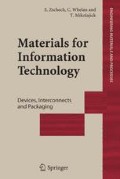Access this chapter
Tax calculation will be finalised at checkout
Purchases are for personal use only
Preview
Unable to display preview. Download preview PDF.
References
Zama, S. et al, “Flip Chip Interconnect Systems Using Wire Stud Bumps and Lead Free Solder,” Proc 50th Electronic Components and Technology Conf, Las Vegas, May 2000.
A. Zribi, et al. “Solder metallization interdiffusion in microelectronic interconnects,” in Proc. 49th IEEE Electron. Comp. Technol. Conf., 1999, p. 451–457.
H. Okamoto, T.B. Massalski, “The Au-Sn(Gold-Tin) System” in Phase diagram of binary gold alloys, p. 278–289, ASM International, Metals Park, Ohio, 1987
Engelmann, G., Ehrmann O., Simon, J., Reichl, H., “Development of a Fine Pitch Bumping Process,” Proc 1st International Conference on Micro, Electro, Opto, Mechanic Systems and Components, Berlin, Germany, 1990.
Dietrich, L., Engelmann, G., Ehrmann, O., Reichl, H., “Gold and Gold-Tin Wafer Bumping by Electrochemical Deposition for Flip Chip and TAB,” 3rd European Conference on Electronic Packaging Technology (EuPac’98), Nuremberg, Germany, June 15–17, 1998.
Kallmayer, C., Oppermann, H.H., Kloeser, J., Zakel, E., Reichl, H.: “Experimental Results on the Self-Alignment Process using Au/Sn Metallurgy and on the Growth of the ζ-Phase During the Reflow”. Proceedings of the International Flip Chip, Ball Grid Array, TAB and Advanced Packaging Symposium (ITAP’ 95), February 1995, San Jose, California, p. 225–236.
Zakel, E., Reichl, H.: “Flip Chip Assembly Using Gold, Gold-Tin, and Nickel-Gold Metallurgy”, in Flip Chip Technologies, ed. John Lau, Chap. 15, McGraw-Hill, 1995.
M. Hutter, H. Oppermann, G. Engelmann, J. Wolf, O. Ehrmann, R. Aschenbrenner et al., Calculation of Shape and Experimental Creation of AuSn Solder Bumps for Flip Chip Applications. 52nd ECTC Electronic Components and Technology Conference, 2002, p 282–8.
Zakel, E.; Reichl, H.: “Au-Sn bonding metallurgy of TAB contacts and its influence on the kirkendall effect in the ternary Cu-Au-Sn”, IEEE Transactions on Components, Hybrids and Manufacturing Technology, 16,3, p. 323–332 (1993).
Anhöck, S., Oppermann, H., Kallmayer, C., Aschenbrenner, R., Thomas, L., Reichl, H.: “Investigations of AuSn Alloys on Different End-Metallizations for High Temperature Applications”. 22nd IEEE/CPMT International Electronics Manufacturing Technology Symposium (IEMT Europe 98), 1998, p. 156–65.
G. Elger, J. Voigt, H. Oppermann: “Application of Flip-Chip Bonders in AuSn Solder Processes to Achieve High After Bonding Accuracy for Optoelectronic Modules”. LEOS 2001. Lasers and Electro-Optics Society, 2001. The 14th Annual Meeting of the IEEE Conference Proceedings, Volume: 2, November 11–15, 2001, San Diego, USA, p. 437–8.
A. Bärwolff, J.W. Tomm, R. Müller, S. Weiß, M. Hutter, H. Oppermann, H. Reichl: “Spectroscopic Measurement of Mounting-Induced Strain in Optoelectronic Devices”. IEEE Transaction on Advanced Packaging, 23,2, p. 170–5 (2000).
G. Elger, R. Jordan, M. v. Suchodoletz, H. Oppermann: Development of an Low Cost Wafer Level Flip Chip Assembly Process for High Brightness LEDs Using the AuSn Metallurgy. 35th International Symposium on Microelectronics, September 4–6, 2002, Denver, Colorado, p. 199–204.
H. Oppermann, E. Zakel, G. Engelmann, H. Reichl: “Investigation of Self-Alignment During Flip-Chip Assembly Using Eutectic Gold-Tin Metallurgy”. 4th Int. Conf. and Exhibition on Micro Electro, Opto and Mechanical Systems and Components, MST’ 94.
B. Rogge, D. Moser, H. Oppermann, O. Paul, H. Baltes: “Solder-Bonded Micromachined Capacitive Pressure Sensors”. Proceedings of SPIE’s Symposium and Continuing Education on Micromachining and Microfabrication, Santa Clara, September 1998, 3514.
Author information
Authors and Affiliations
Editor information
Editors and Affiliations
Rights and permissions
Copyright information
© 2005 Springer-Verlag London Limited
About this chapter
Cite this chapter
Oppermann, H. (2005). The Role of Au/Sn Solder in Packaging. In: Zschech, E., Whelan, C., Mikolajick, T. (eds) Materials for Information Technology. Engineering Materials and Processes. Springer, London. https://doi.org/10.1007/1-84628-235-7_31
Download citation
DOI: https://doi.org/10.1007/1-84628-235-7_31
Publisher Name: Springer, London
Print ISBN: 978-1-85233-941-8
Online ISBN: 978-1-84628-235-5
eBook Packages: EngineeringEngineering (R0)

